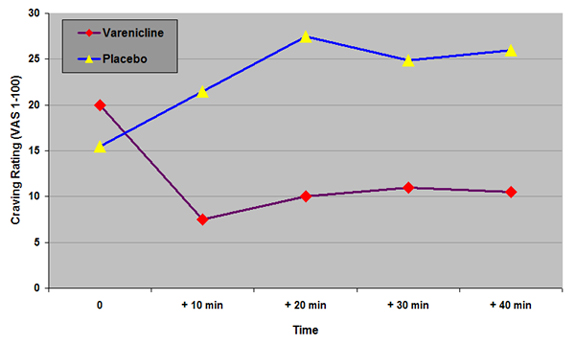Research has shown that alcohol and tobacco dependence are often comorbid disorders (Grant, 1998; McKee, Falba, O’Malley, Sindelar, & O’Connor, 2007). Research also shows that some of the chemical treatments used for smoking cessation may be used to treat alcohol consumption and craving. This week the DRAM reviews a study that tested the effects of varenicline, a new FDA approved treatment for smoking cessation, on alcohol consumption in heavy smokers and drinkers (McKee et al., 2009).
Methods:
- The researchers conducted a double-blind, placebo controlled study examining the effect of varenicline on alcohol self-administration.
- Participants (N=20) were eligible if they were ≥ 21 years old, smoked ≥ 10 cigarettes daily, and drank multiple drinks multiple days per week but were not alcohol dependent.
- Participants took varenicline or a placebo for 7 days prior to completing a 14-hour laboratory session that included two 1-hour alcohol self-administration sessions.
- The researchers measured alcohol craving prior to and during the alcohol self-administration sessions.
Results:

Figure. Alcohol craving before and during alcohol self-administration sessions (adapted from McKee et al., 2009). Click image to enlarge.
*VAS is a visual analogue scale, i.e., a continuous scale on which participants mark a point indicating their response
- Alcohol cravings decreased in the varenicline group but increased in the placebo group across time (time x medication, F = 2.57, p < .05) (see Figure).
- Participants who took varenicline consumed significantly fewer drinks than participants who took a placebo during the self-administration periods (varenicline M = 0.5, SD = .40; placebo M = 2.60, SD = .9; p < .05).
Limitations:
- The sample size was small.
- The results might not generalize to all drinking populations because the drug was not tested on people with alcohol dependence or people who did not smoke.
- The effects of this drug were tested in a laboratory, not in actual social drinking situations.
Conclusion:
This study demonstrated that varenicline was able to inhibit alcohol consumption and craving in people who are heavy drinkers and smokers. Varenicline use had minimal adverse effects. Given that the majority of drinkers smoke, varenicline seems like a promising drug to treat people with dual alcohol and tobacco disorders.
— Tasha Chandler
What do you think? Please use the comment link below to provide feedback on this article.
References:
Grant, B. F. (1998). Age at smoking onset and its association with alcohol consumption and DSM-IV alcohol abuse and dependence: Results from the National Longitudinal Alcohol Epidemiologic Survey. Journal of Substance Abuse, 10(1), 59-73.
McKee, S. A., Falba, T., O’Malley, S. S., Sindelar, J., & O’Connor, P. G. (2007). Smoking status as a clinical indicator for alcohol misuse in US adults. Archives of Internal Medicine, 167(7), 716-721.
McKee, S. A., Harrison, E. L., O’Malley, S. S., Krishnan-Sarin, S., Shi, J., Tetrault, J. M., et al. (2009). Varenicline reduces alcohol self-administration in heavy-drinking smokers. Biological Psychiatry (In Press).





Gerald A. Bunn, MA June 4, 2009
I think your “Limitation” of not being done in a social setting is a major one as many smokers as well as drinkers are heavily influenced by their peers and the “occassion”.